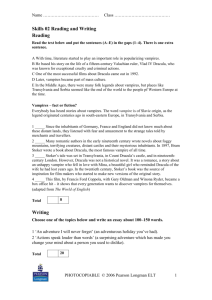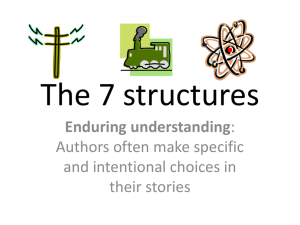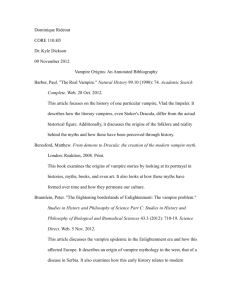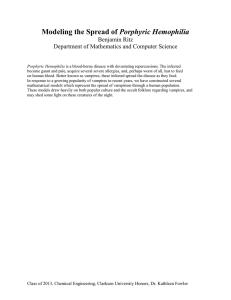AREAS OF INQUIRY GLOBAL AND MULTICULTURAL
advertisement
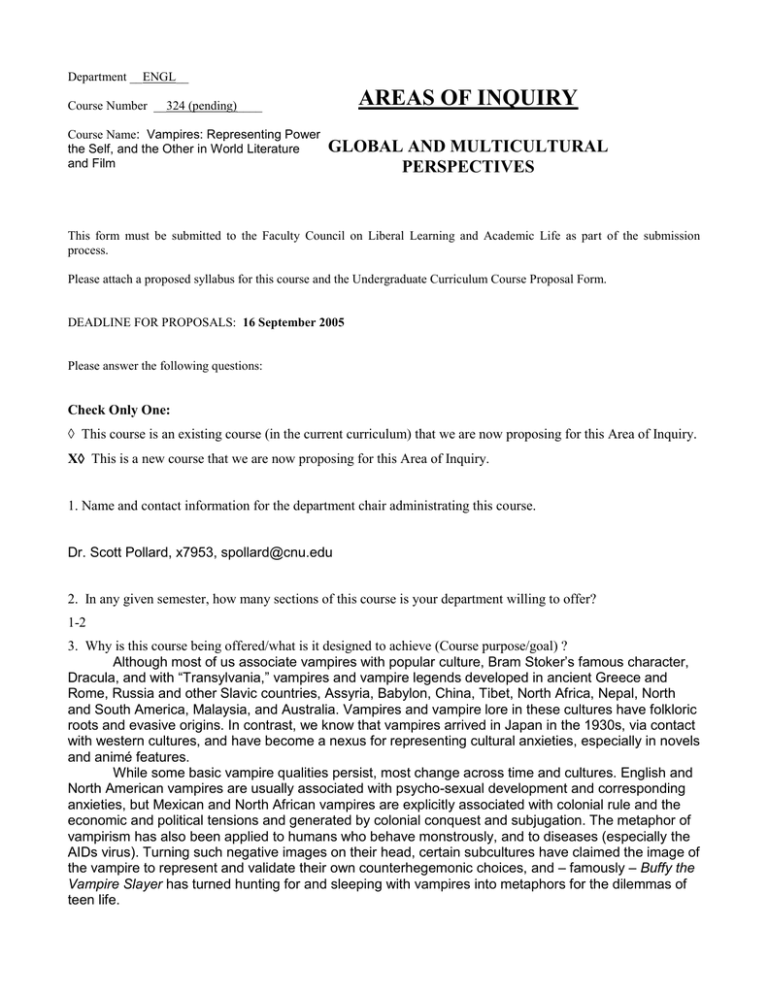
Department __ENGL__ AREAS OF INQUIRY Course Number __324 (pending)____ Course Name: Vampires: Representing Power the Self, and the Other in World Literature and Film GLOBAL AND MULTICULTURAL PERSPECTIVES This form must be submitted to the Faculty Council on Liberal Learning and Academic Life as part of the submission process. Please attach a proposed syllabus for this course and the Undergraduate Curriculum Course Proposal Form. DEADLINE FOR PROPOSALS: 16 September 2005 Please answer the following questions: Check Only One: This course is an existing course (in the current curriculum) that we are now proposing for this Area of Inquiry. X This is a new course that we are now proposing for this Area of Inquiry. 1. Name and contact information for the department chair administrating this course. Dr. Scott Pollard, x7953, spollard@cnu.edu 2. In any given semester, how many sections of this course is your department willing to offer? 1-2 3. Why is this course being offered/what is it designed to achieve (Course purpose/goal) ? Although most of us associate vampires with popular culture, Bram Stoker’s famous character, Dracula, and with “Transylvania,” vampires and vampire legends developed in ancient Greece and Rome, Russia and other Slavic countries, Assyria, Babylon, China, Tibet, North Africa, Nepal, North and South America, Malaysia, and Australia. Vampires and vampire lore in these cultures have folkloric roots and evasive origins. In contrast, we know that vampires arrived in Japan in the 1930s, via contact with western cultures, and have become a nexus for representing cultural anxieties, especially in novels and animé features. While some basic vampire qualities persist, most change across time and cultures. English and North American vampires are usually associated with psycho-sexual development and corresponding anxieties, but Mexican and North African vampires are explicitly associated with colonial rule and the economic and political tensions and generated by colonial conquest and subjugation. The metaphor of vampirism has also been applied to humans who behave monstrously, and to diseases (especially the AIDs virus). Turning such negative images on their head, certain subcultures have claimed the image of the vampire to represent and validate their own counterhegemonic choices, and – famously – Buffy the Vampire Slayer has turned hunting for and sleeping with vampires into metaphors for the dilemmas of teen life. This course will provide students with the opportunity to study these images across time and cultures, and to address questions of power, whether related to gender roles and social position, or to issues of invasion and conquest, and economic dominance or submission. This course also permits students to examine the relationship between high and popular culture, folklore, religion and ritual, myth and legend. 4. Check the objectives below that the course will address. The first objective is required and every proposal must include at least two more objectives from the list below. X Interrogate the dominate culture in relationship to other cultures (required) Compare communication styles among cultures X Assess how culture impacts and informs the development of creative expression/movements, politics, economics, or philosophy X Analyze how concepts of “self” and individuals in various cultures differ and/or intersect Articulate how culture influences the structure of languages, societies, and institutions 5. Briefly explain how this class addresses the above objectives. A course may cover more than three objectives. a.) Because the vampire image in so many cultures involves the relation between colonial powers and indigenous populations (as well as, in Dracula, the mirror image of that: fear of reverse colonization), the metaphor of the vampire serves as a rich nexus for exploring the relationship between dominant and other cultures as well as the construction of the Other. This course will also present subaltern studies to students as an alternative to reading and analyzing from the perspective of dominance. b.) Because the image of the vampire arises in folklore, fiction, theatre, film, ballet, opera, and the plastic arts, this course will ask students to explore the ways in which socio-political structures and tensions manifest themselves in the arts and literature. Consequently, the texts for this course will be entirely multimedia. Lectures, readings, and discussions will instruct students in visual and other literacies necessary for thorough analysis of these texts. c.) This course will also allow a comparative analysis of the concept of the ‘self’ over time and across cultures. Thinkers as early as Augustine of Hippo and Isidore of Seville recognized that the notion of the monster, permits the construction of the “self” in contrast to the monstrous “other.” This relationship has been further theorized by psychology, literary theory and cultural studies. This course will introduce students to these ideas, via a series of articles and lectures, which will form the basis of our discussions of vampires as a locus for exploring the uncanny relationship between the self and other – which will also permit greater depth to our discussion about inter-cultural relationships and tensions. 6. Course Assessment: Identify how this course will accomplish the above objectives (choose at least one): X Participating in class discussion and debate X Engaging in teamwork and other collaborative exercises X Writing analytical or evaluative papers, perhaps incorporating original research X Making oral presentations Creating an artistic product or a performance Participating in fieldwork Other means – please identify 7. Attach a proposed syllabus, which includes a statement of purpose, course objectives, and how these objectives will be accomplished. See attached 8. Please identify and explain if this course contributes to the Foundations of Liberal Learning expectations for: Oral Communication Literacy: This course will foster learning in the area of Oral Communication Literacy because students will be asked to engage actively in classroom discussion and debate. In addition, students will present their ideas and research to each other in a final, formal, oral presentation. Information Literacy: This course will foster learning in the area of Information Literacy because it will demand the discovery and evaluation of solid, academic sources in relation to a complex, excessively popular topic. One of the reasons for choosing “Researching Dracula” as my pilot and premiere topic for ENGL 223 is the fact that there is a tremendous amount of misinformation out there on the web in relation to vampires. This course demands that students learn to find solid scholarly sources, to work with library resources (whether print or electronic) and to evaluate these sources. The base texts and discussions in the class will help students develop a core expertise, which they will then use in their own research for their final paper and presentation. Writing Literacy: This course will involve regular informal writings, as well as a research paper proposal, a final paper, a midterm and final exam in essay format. Classroom discussions will encourage students to think, to consider new ideas, and to refute opposing viewpoints, as well as foster clarity of thought, all of which are the first steps to successful writing. 9. Explain how this course connects to Vision 2010 – the CNU Strategic Plan. Although the topic of this course is usually relegated to the supposedly inconsequential realms of fantasy, terror and suspense, serious study of the vampire metaphor is profoundly interdisciplinary and international – yet it also remains intensely personal. Because vampires cross political and personal boundaries, the study of the vampire metaphor elicits a more nuanced understanding of oneself, one’s place in the world and one’s relation to others. This course engages the principles of liberal learning by demanding academic excellence, self-reflection, and an open mind in relation to study, politics, and gender. Consequently, “Vampires: Representing Power, the Self and the Other in World Literature and Film” fits neatly into CNU’s Vision 2010. One of the goals of Vision 2010 is to “prepare students to lead lives of significance and responsibility in a free, democratic society.” This class will ask students to think about power politics, about the ways in which colonization has changed the way the world thinks, as well as what representations of vampires tell us about global perspectives. Reading texts that permit us to examine other cultural perspectives, and closely examining the impact of the US and other world powers on subaltern cultures will make students better aware of our international responsibilities and will encourage them to participate more thoughtfully in the democratic process. Another goal of Vision 2010 is to: “create independent learners prepared intellectually and practically to understand the world.” This course will contribute to students’ abilities to think independently because it addresses the relationship between subcultures and dominant cultures, often from the perspective of the subculture. Students will be asked to questions themselves, their sources, their relationship to authority, and to discuss and write about the implications of such questions and exploration in the world. Submission Checklist: By the deadline, submit a packet with the following documents to the Assistant Dean for Liberal Learning. Please submit in electronic and hard copy form. _____ Area of Inquiry Course Proposal Form _____ Syllabus for the Course _____ Undergraduate Curriculum Committee Course Proposal Form English 324 Vampires: Representing Power, the Self, and the Other in World Literature and Film Dr. Sharon M. Rowley Office: Ratcliffe 222; 594.8874; srowley@cnu.edu Office Hours: tba Course Description: Although most of us associate vampires with popular culture, Bram Stoker’s famous character, Dracula, and with “Transylvania,” vampires and vampire legends developed in ancient Greece and Rome, Russia and other Slavic countries, Assyria, Babylon, China, Tibet, North Africa, Nepal, North and South America, Malaysia, and Australia. Vampires and vampire lore in these cultures have folkloric roots and evasive origins. In contrast, we know that vampires arrived in Japan in the 1930s, via contact with western cultures, and have become a nexus for representing cultural anxieties, especially in novels and animé features. While some basic vampire qualities persist, most change across time and cultures. English and North American vampires are usually associated with psycho-sexual development and corresponding anxieties, but Mexican and North African vampires are explicitly associated with colonial rule and the economic and political tensions and generated by colonial conquest and subjugation. The metaphor of vampirism has also been applied to humans who behave monstrously, and to diseases (especially the AIDs virus). Turning such negative images on their head, certain subcultures have claimed the image of the vampire to represent and validate their own counterhegemonic choices, and – famously – Buffy the Vampire Slayer has turned hunting for and sleeping with vampires into metaphors for the dilemmas of teen life. This course will provide students with the opportunity to study these images across time and cultures, and to address questions of power, whether related to gender roles and social position, or to issues of invasion and conquest, and economic dominance or submission. This course also permits students to examine the relationship between high and popular culture, folklore, religion and ritual, myth and legend. Students will take two exams, write a proposal and a research paper, as well as present their findings to the class in an oral presentation. Required Texts: Ellis, Bill, "The Highgate Cemetary Vampire Hunt: The Anglo-American Connection in Satanic Cult Lore," Folklore, 104.1/2, 1993 (JSTOR) Gogol, Nikolai, Viy Jarosz, Lucy A. "Agents of Power, Landscapes of Fear: The Vampires and Heart Thieves of Madagascar." Environment and Planning D: Society and Space (August 1994), 12(4):425, 435. Musambachime, Mwelwa, "The Impact of Rumor: The Case of the Banyama (Vampire Men) Scare in Northern Rhodeisa, 1930-64," International Journal of African Historical Studies 21.2, 1988. Oinas, Felix, J. "Heretics as Vampires and Demons in Russia," Slavic and East European Journal 22.4, 1978 (JSTOR) Ramos, Maximo, "The Aswang Syncrasy in Philippine Folklore," Western Folklore, 28.4, 1969 (JSTOR) Stetson, George R. “The Animistic Vampire in New England,” American Anthropologist, IX.1, 1896 (JSTOR) Stoker, Bram. Dracula: A Norton Critical Edition, ed. Nina Auerbach and David Skal. Norton, 1997 Swensen, Andrew. “Vampirism in Gogol's Short Fiction” Slavic and East European Journal. 37.4, 1993 Trigo, Benigno, "Anemia and Vampires: Figures to Govern the Colony, Puerto Rico, 1880- 1904, Comparative Studies in Society and History 41.1, 1999 (JSTOR) White, Luise. Speaking with Vampires: Rumor and History in Colonial Africa. Berkeley: University of California Press, c2000 2000. E-text available: http://ark.cdlib.org/ark:/13030/ft8r29p2ss/ Films: Blood: The Last Vampire, Hiroyuki Kitakubo, Japan, 2000 Fantomas, Luis Feuillade, France 1913 La Invasion de los Vampiros, Miguel Morayta, Mexico 1961 Nosferatu, F.W. Murnau, Germany, 1922 Vampire Hunters, Tsui Hark, China, 2002 Books on Reserve: Baddeley, Gavin. Goth Chic: A Connoisseur’s Guide Dark Culture. London: Plexus, 2002. Cavallaro, Dani. The Gothic Vision: Three Centuries of Horror, Terror, and Fear. London: Continuum, 2002. Freccero, Carla. Popular Culture: An Introduction. New York: NYU Press, 1999. Gelder, Ken. Reading the Vampire. London: Routledge, 1994. Gordon, Joan and Veronica Hollinger, eds. Blood Read: The Vampire as Metaphor in Contemporary Culture. Philadelphia: U Penn Press, 1997. Course Requirements: 1. Your responsibilities: Read this syllabus! That means: read this syllabus now, and consult it for assignments and due dates. In order to pass this class, you must conform to all requirements and fulfill all assignments listed below. Should I need to make any changes, I will announce those changes at least one week in advance during the first five minutes of class. 2. Attendance: I expect students to attend class. I will circulate a sign-in sheet at the beginning of each class. You are responsible for signing yourself in every day. Except in the case of serious illness, the final grade of students who miss four classes will be downgraded a full letter grade for absences. Students who miss six or more classes will automatically fail. If you are ill, bring medical documentation. Missed in-class work cannot be made up. Also, please be respectful of your classmates, and arrive punctually. Arriving to class more than five minutes late three times will count as one absence. 3. Participation: I expect all students to participate in class discussions. READ and THINK. Get in the habit of analyzing, comparing, contrasting, questioning. I consider a student who comes to class with a well thought out question, set of questions -- or even objections -- to be as prepared for discussion as a student who arrives with a fully articulated literary critique of the day's reading. 4. Proposal and Paper: I believe that we all write better when we're writing about something in which we are interested. So, your paper will be on a topic of your choice (developed, if you like, in conference with me). You will write a proposal, statement of methodology, and a review of current scholarship as we progress towards the final paper. You will do peer reviews of a draft of your essay with your classmates and revise before you turn in a final copy. Be aware that you should be thinking about and working on your own paper for the whole term. I have scheduled in-class screenings towards the end of the term to facilitate your independent work. For the final draft, use MLA style. Please be sure to proofread & spell-check. After the second typographical error, I will return the essay to you for proofreading and lower your grade one full letter grade per class until the paper is resubmitted. 5. Grading: proposal research paper midterm exam final exam participation 10 40 20 20 10 6. Honor Code: Students will adhere to the CNU honor code. Refer to your University Writing Guide or your student handbook for details, but understand that plagiarism will not be tolerated. 7. CNU Disability Policy: Any student who believes that (s)he is disabled should make an appointment to discuss his or her needs. In order to receive an accommodation, student disability should be on record at the Academic Advising Center, 594.8673 Tentative Schedule Weeks 1-2: Dracula, Colonialism and Capital Stoker, Dracula. Also: Arata, "The Occidental Tourist" (in the Norton Critical Edition), Moretti, “A Capital Dracula," (in the Norton) Week 3: Week 4: Week 5-6: Fantomas, Luis Feuillade, France 1913; secondary readings tba Nosferatu, F.W. Murnau, Germany, 1922; reading from Gelder, on reserve White, Luise. Speaking with Vampires: Rumor and History in Colonial Africa. Berkeley: University of California Press, c2000 2000 Jarosz, Lucy A. "Agents of Power, Landscapes of Fear: The Vampires and Heart Thieves of Madagascar." Musambachime, Mwelwa, "The Impact of Rumor: The Case of the Banyama (Vampire Men) Scare in Northern Rhodeisa, 1930-64," Week 7: Review and Midterm Exam Week 8: La Invasion de los Vampiros, Miguel Morayta, Mexico 1961 Week 9: Trigo, Benigno, "Anemia and Vampires: Figures to Govern the Colony, Puerto Rico, 1880-1904, Comparative Studies in Society and History 41.1, 1999 (JSTOR) *proposal due* Week 10: Stetson, George R. “The Animistic Vampire in New England,” American Anthropologist, IX.1, 1896 (JSTOR) Ellis, Bill, "The Highgate Cemetary Vampire Hunt: The Anglo-American Connection in Satanic Cult Lore," Folklore, 104.1/2, 1993 (JSTOR) Week 11: Nikolai Gogol, Viy (and the 1967 Russian film, if I can get it) Oinas, Felix, J. "Heretics as Vampires and Demons in Russia," Slavic and East European Journal 22.4, 1978 (JSTOR) Swensen, Andrew. “Vampirism in Gogol's Short Fiction” Slavic and East European Journal. 37.4, 1993 Week 12: Blood: The Last Vampire, Hiroyuki Kitakubo, Japan, 2000; Kotani, Mari, “Techno-Gothic Japan” in Blood Read, on reserve Week 13: Vampire Hunters, Tsui Hark, China, 2002 Weeks 14-5: Oral presentations UNDERGRADUATE CURRICULUM COMMITTEE NEW COURSE PROPOSAL FORM Does this proposal affect Liberal Learning requirements? Yes __X___ No ___ 1. Title of Course: Vampires: Representing Power, the Self, and the Other in World Literature and Film Proposed Course Number (cleared with Registrar): ENGL 324 Prerequisite Courses: ENGL 123-223 (if you require a minimum acceptable grade greater than the default of D- , please indicate the grade you require) ____C__ Catalogue Description (including credits, lecture, and lab hours): In this course, students will explore vampire images across a variety of cultures and periods. Although most of us associate vampires with popular culture, Bram Stoker’s famous character, Dracula, and with “Transylvania,” vampires and vampire legends developed in ancient Greece and Rome, Russia and other Slavic countries, Assyria, Babylon, China, Tibet, North Africa, Nepal, North and South America, Malaysia, Australia and Japan. While some basic vampire qualities persist, most change across time and place. Students will interrogate these changes, along with questions of power, gender, social status, invasion and economic dominance. This course also engages students in an examination of the relationship between high and popular culture, folklore, religion and ritual, myth and legend. Students will write two exams, a proposal and a research paper, then present their findings to the class in an oral presentation. Is the course cross-listed? If so, what is the number of the other course? NA **A proposed syllabus, including complete text and/or reference information, as well as any relevant information to this decision, must be appended. NOTE: All affected department chairs must sign approval on last page. 2. For whom is the course primarily intended? Explain why it should be added to the curriculum. Non-majors seeking to fulfill an Area of Inquiry requirement. 3. If this course is required, append a description of how the course fits into the curriculum. Indicate how it affects hours required for graduation. NA 4. Has this course been offered previously as a special topics course? If so, when? What course number was used? No 5. Has this course, or one closely related to it, been offered at CNU previously? If so, is that course currently being offered? How does the proposed course differ? When is the last term the old course will be offered? I have developed this course because of the tremendous amount of interest generated by the ENGL223: “Researching Dracula.” At least half of the time in “Researching Dracula” is spent on teaching research writing, and the relevant skills (writing, documentation, evaluating sources, etc). Because of the time constraints in 223 because of the writing and research components, the theme materials focus primarily on images of the vampire in the Anglo-American tradition. ENGL 324 differs greatly from “Researching Dracula,” in that it is a 300-level course designed to study the image of the vampire across cultures and in a variety of media. ENGL 324 will presume basic writing and research skills (because of the 123-223 prerequisites), and will therefore be able to interrogate a wider variety of vampire texts from a much larger range of cultures and disciplines, in much greater depth. 6. What is the anticipated enrollment per offering for the next three years? During which term will this course first be offered? Fall 20__ Spring 2007_ Summer 20___ During which semesters will this course regularly be offered? Fall 20___ Spring 20___ Summer 20___ Print in the _2006-7__ (academic year) Undergraduate Catalog. 7. How will the course be staffed? This course can be staffed either by Dr. Rowley or Dr. Marinova 8. Does the course involve a particular classroom, special equipment, or costs beyond those usually associated with a course at CNU? If so, please explain. NO 9. Is the course repeatable for additional credit? If so, is there a limit to the number of times the course can be repeated? (e.g., applied music courses) NO 10. If this course is for an Area of Inquiry a. Identify the Area of Inquiry _Global and Multicultural Perspectives______ b. Demonstrate how your course will meet the objectives of this Area of Inquiry This course will study texts from a broad range of cultural perspectives from a comparative point of view, and by doing so improve students’ understanding of their (cultural) place in this world. Because of the pervasive popularity of vampire images and legends, instructors can draw on texts from ancient Greece and Rome, Russia and other Slavic countries, Assyria, Babylon, China, Tibet, North Africa, Nepal, North and South America, Malaysia, Japan, and Australia – so this course is truly about global perspectives. Because the vampire image in so many cultures involves the relation between colonial powers and indigenous populations (as well as, in Dracula, the mirror image of that: fear of reverse colonization), the metaphor of the vampire serves as a rich nexus for exploring the relationship between dominant and other cultures as well as the construction of the Other. This course will also present subaltern studies to students as an alternative to reading and analyzing from the perspective of dominance. This course was approved by: (Liberal learning core courses must be reviewed by BOTH academic Deans.) | Department(s): (1) Date: ________ (2) Date: ________ College Curriculum Committee: Date: ________ Dean: Date: ________ Dean: Date: ________ Undergraduate Curriculum Committee: Date: ________ Concur Changes to the Liberal Learning requirements must be reviewed by the Faculty Senate. Faculty Senate President: Date: ________ Provost Date: ________ Distribution by Provost Office following approval: Department Chair(s), UCC Chair, Deans, Registrar ** If “Do Not Concur” is checked, please attach a statement of explanation. Rev. 03/20/05 Do Not Concur**

